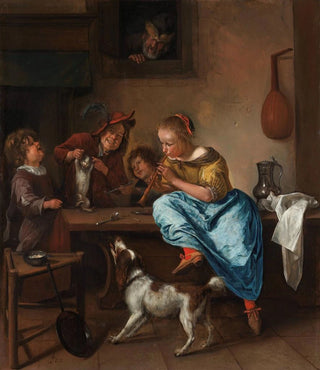Art print | The Dance Lesson - Jan Steen


View from behind

Frame (optional)
In the vibrant world of 17th-century Dutch painting, the artwork "The Dance Lesson" by Jan Steen stands out for its lively atmosphere and visual storytelling. This canvas, full of joie de vivre, immerses us in a convivial scene where the art of dance blends seamlessly with everyday life. The characters, with animated expressions and graceful gestures, seem to invite the viewer to share this moment of lightness and pleasure. The art print of "The Dance Lesson" by Jan Steen allows for a rediscovery of this iconic piece, while offering a window into a world where art and life intertwine harmoniously.
Style and uniqueness of the work
Jan Steen's style is recognizable by his meticulous attention to detail and masterful use of light. In "The Dance Lesson," the composition is carefully orchestrated, with each character occupying a significant place within the overall scene. The vibrant colors and interplay of shadow and light give the scene a palpable dynamism. The depiction of figures, both realistic and expressive, demonstrates a deep understanding of human nature. Steen manages to capture not only the movements of the dance but also the emotions that arise from them, creating a piece that resonates with the viewer. Far from being a simple illustration of a social activity, this canvas becomes a living tableau—a celebration of joy and human interaction.
The artist and his influence
Jan Steen, born in 1626, is one of the undisputed masters of the Dutch Golden Age. His career is marked by a diversity of themes, ranging from genre scenes to portraits, including representations of daily life. The artist, often regarded as a chronicler of his time, uses his brush to paint narratives that go beyond mere depiction. His influence is undeniable, inspiring many artists across the centuries. Steen was able to capture the essence of Dutch life with such authenticity that he became an essential reference for those seeking to understand the richness of this artistic period. His ability to blend humor and reflection in his works has fostered an timeless dialogue between art and the viewer.

Matte finish

View from behind

Frame (optional)
In the vibrant world of 17th-century Dutch painting, the artwork "The Dance Lesson" by Jan Steen stands out for its lively atmosphere and visual storytelling. This canvas, full of joie de vivre, immerses us in a convivial scene where the art of dance blends seamlessly with everyday life. The characters, with animated expressions and graceful gestures, seem to invite the viewer to share this moment of lightness and pleasure. The art print of "The Dance Lesson" by Jan Steen allows for a rediscovery of this iconic piece, while offering a window into a world where art and life intertwine harmoniously.
Style and uniqueness of the work
Jan Steen's style is recognizable by his meticulous attention to detail and masterful use of light. In "The Dance Lesson," the composition is carefully orchestrated, with each character occupying a significant place within the overall scene. The vibrant colors and interplay of shadow and light give the scene a palpable dynamism. The depiction of figures, both realistic and expressive, demonstrates a deep understanding of human nature. Steen manages to capture not only the movements of the dance but also the emotions that arise from them, creating a piece that resonates with the viewer. Far from being a simple illustration of a social activity, this canvas becomes a living tableau—a celebration of joy and human interaction.
The artist and his influence
Jan Steen, born in 1626, is one of the undisputed masters of the Dutch Golden Age. His career is marked by a diversity of themes, ranging from genre scenes to portraits, including representations of daily life. The artist, often regarded as a chronicler of his time, uses his brush to paint narratives that go beyond mere depiction. His influence is undeniable, inspiring many artists across the centuries. Steen was able to capture the essence of Dutch life with such authenticity that he became an essential reference for those seeking to understand the richness of this artistic period. His ability to blend humor and reflection in his works has fostered an timeless dialogue between art and the viewer.






